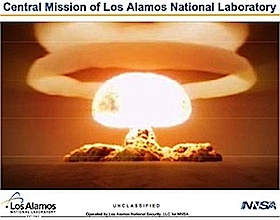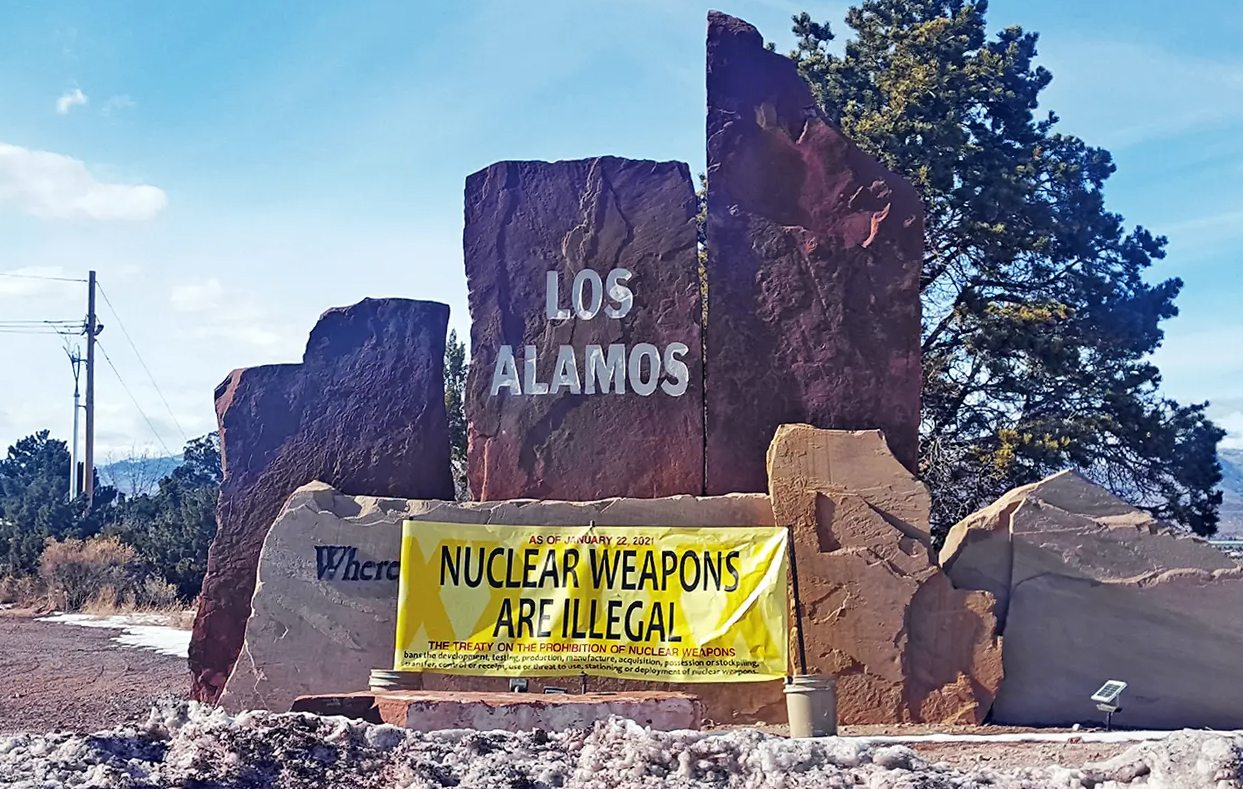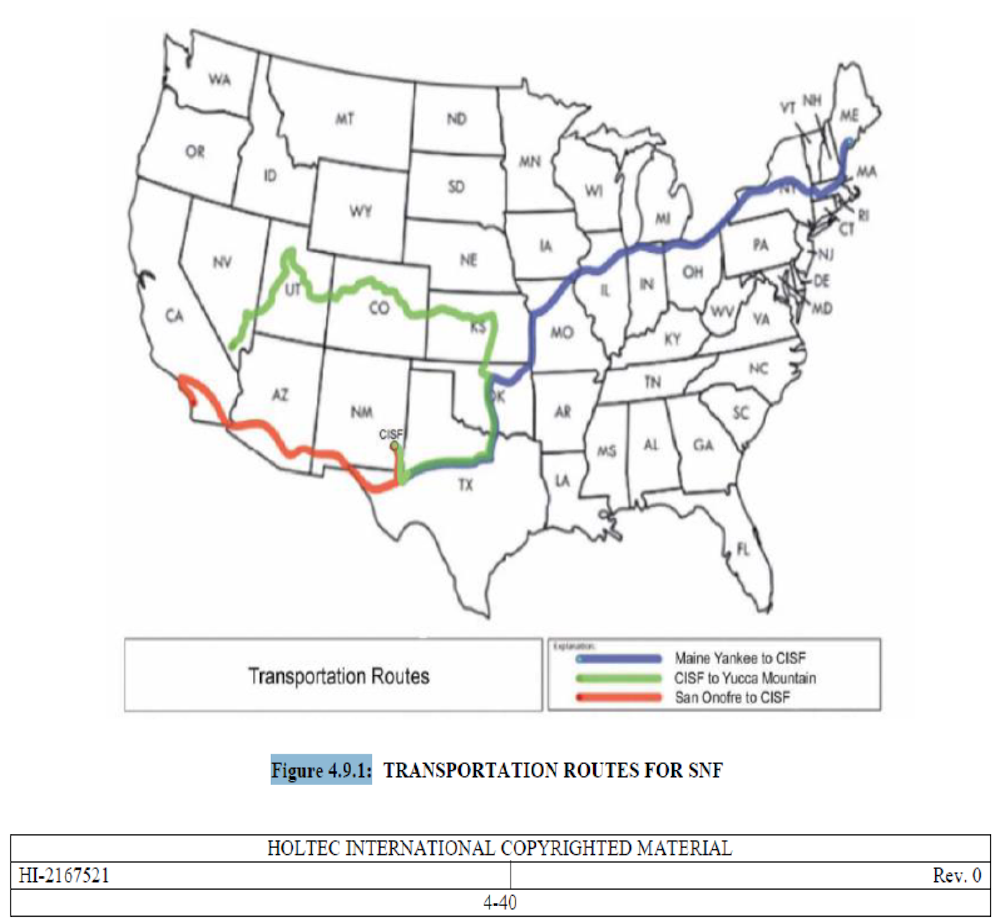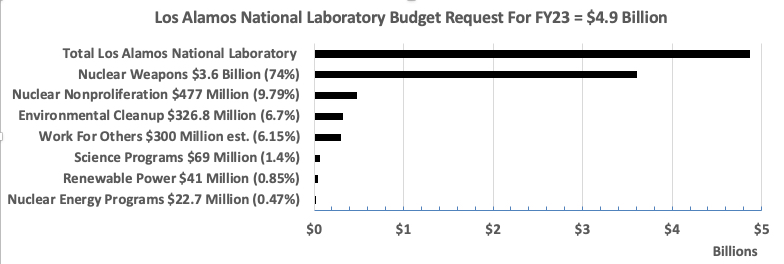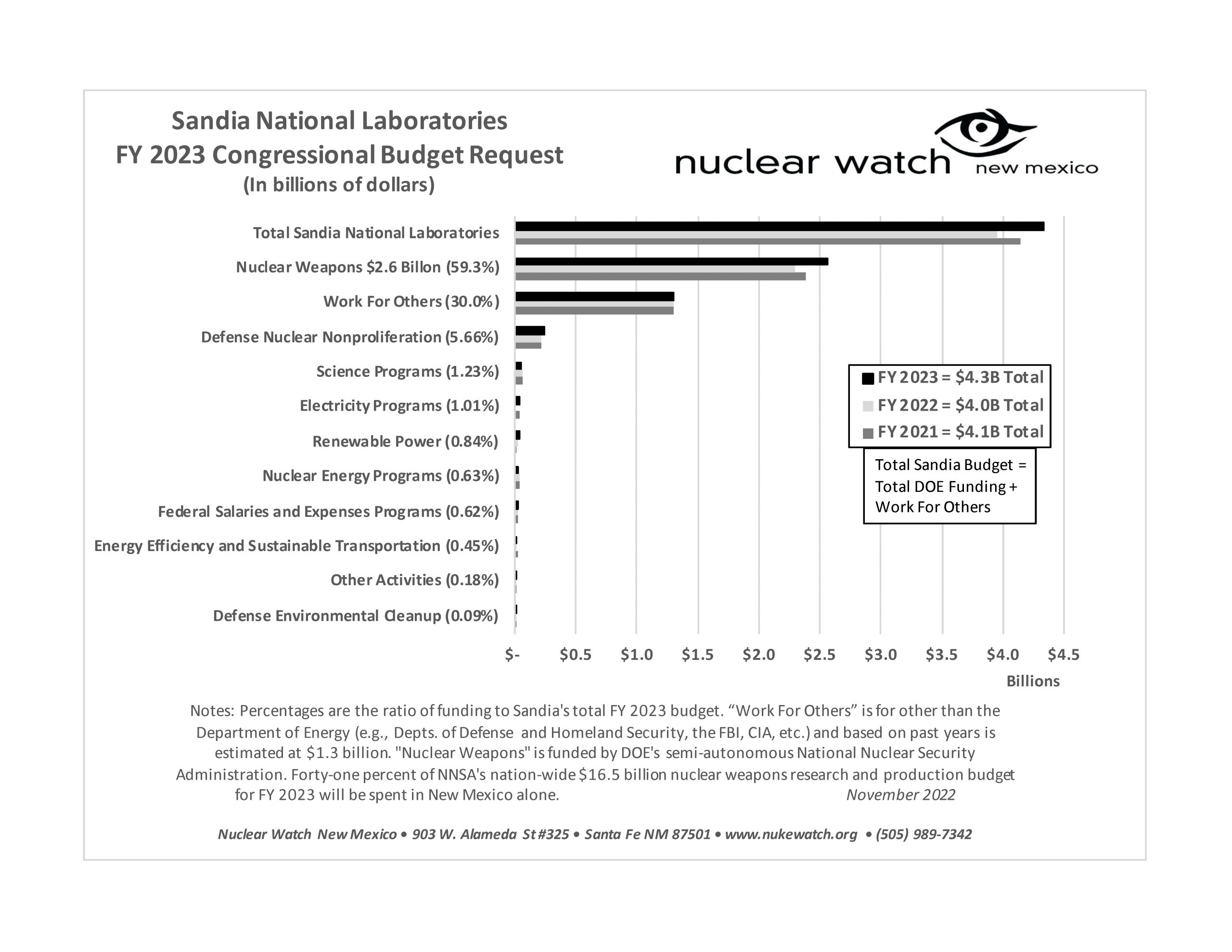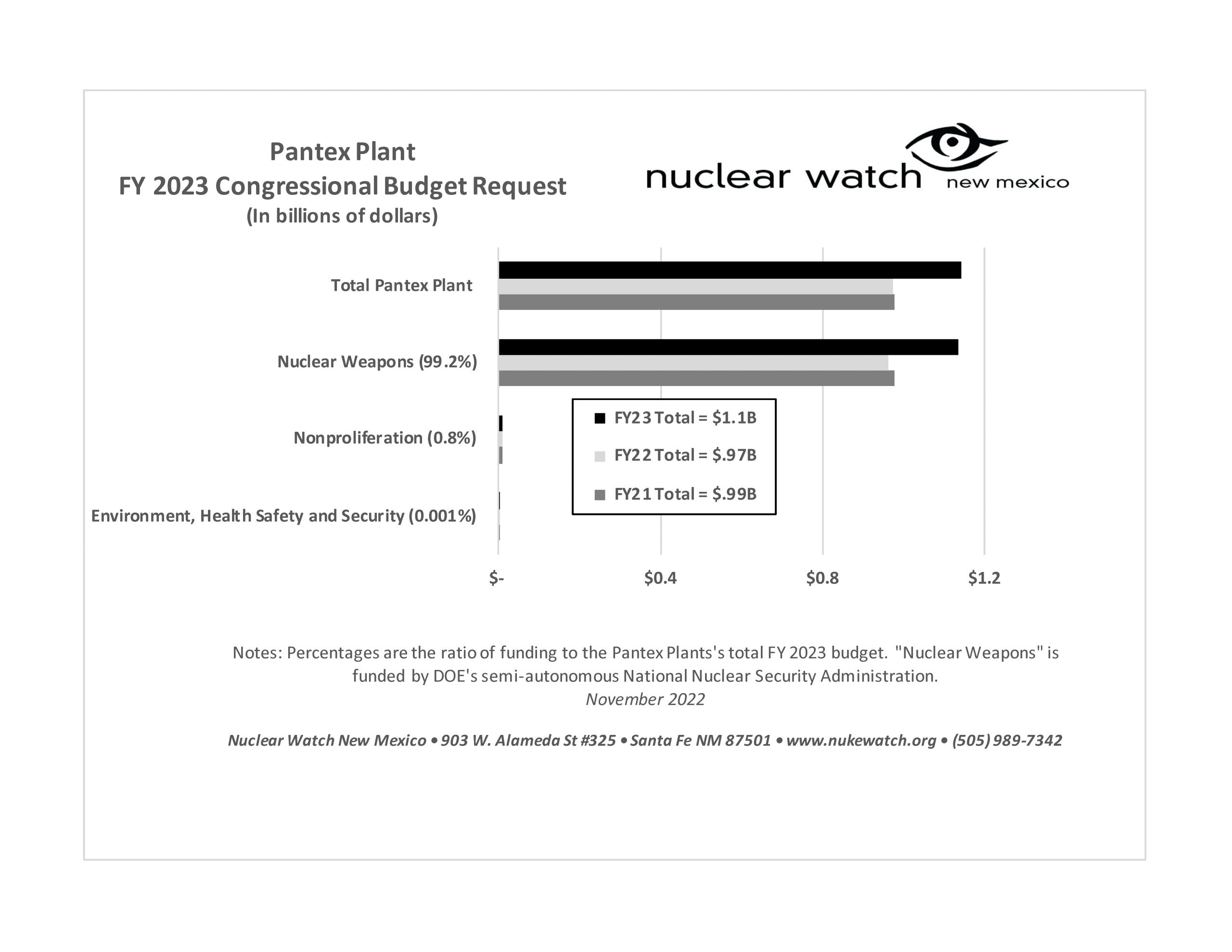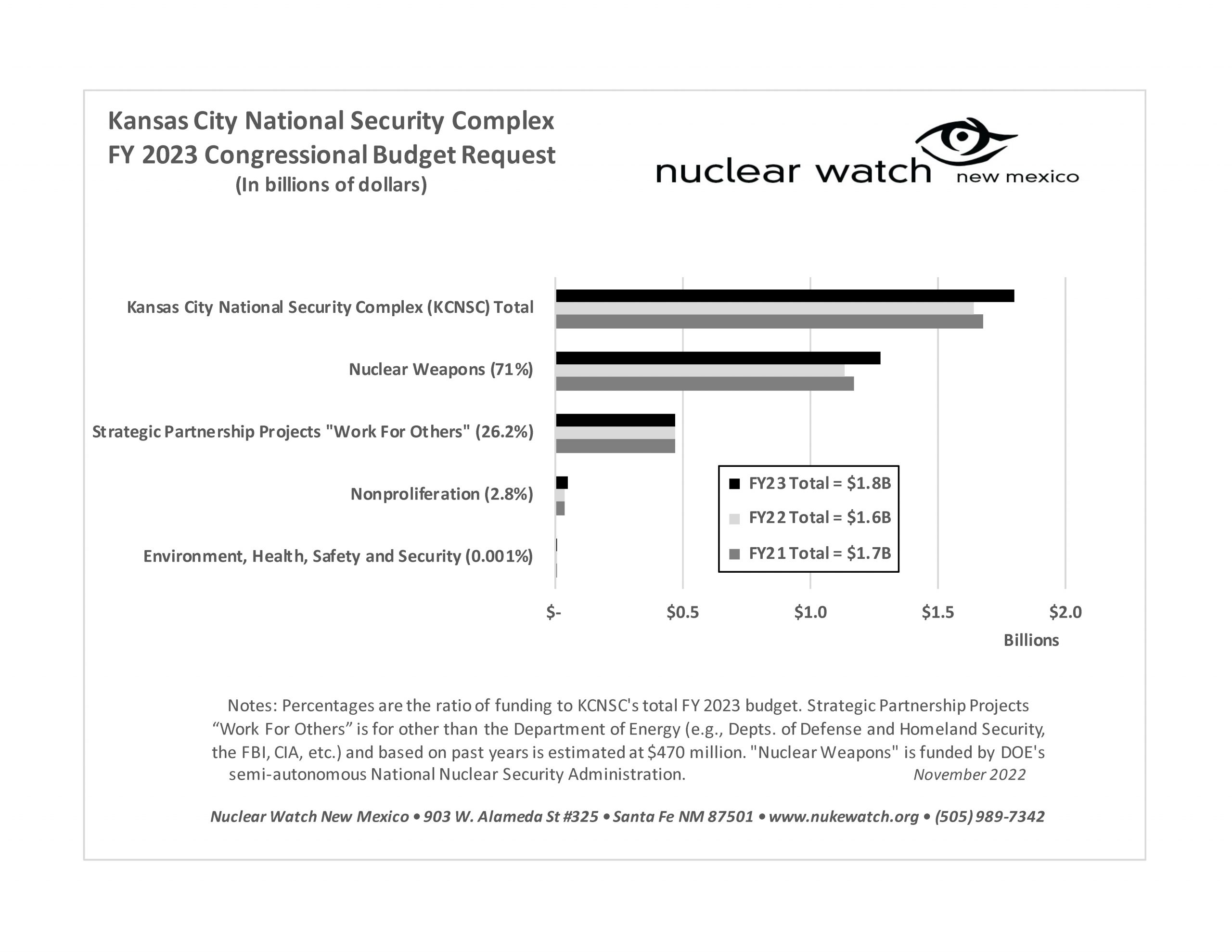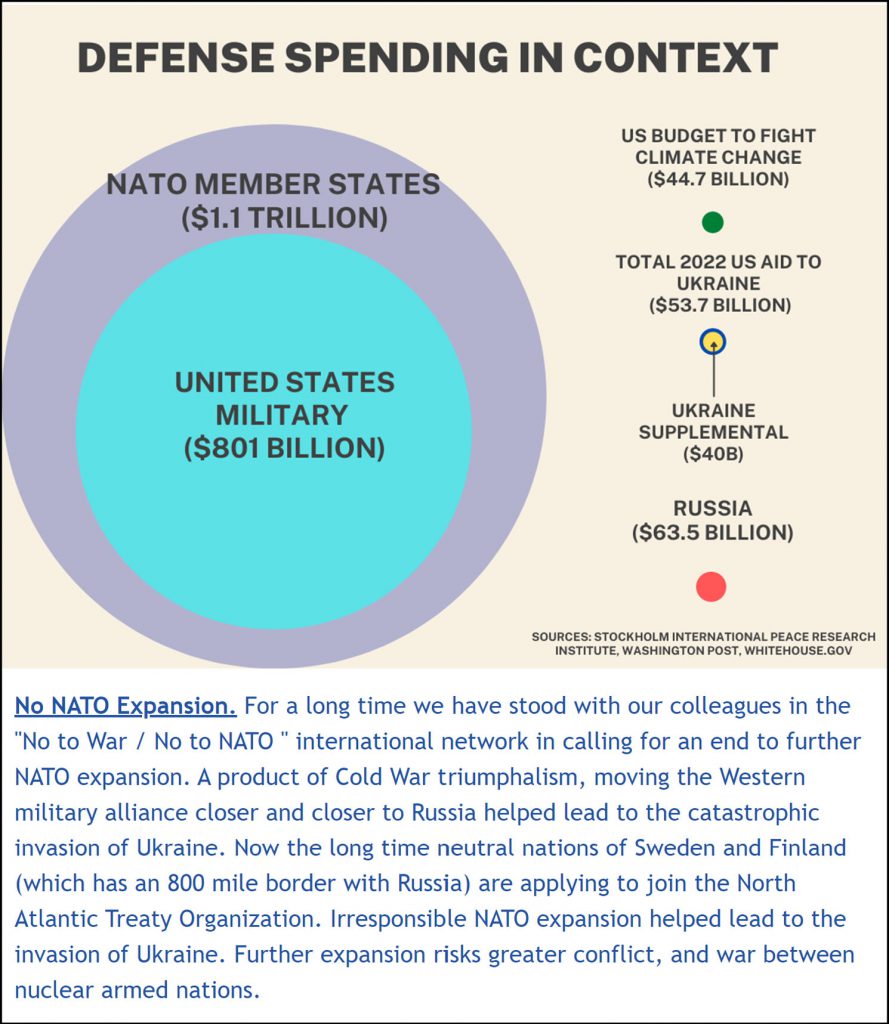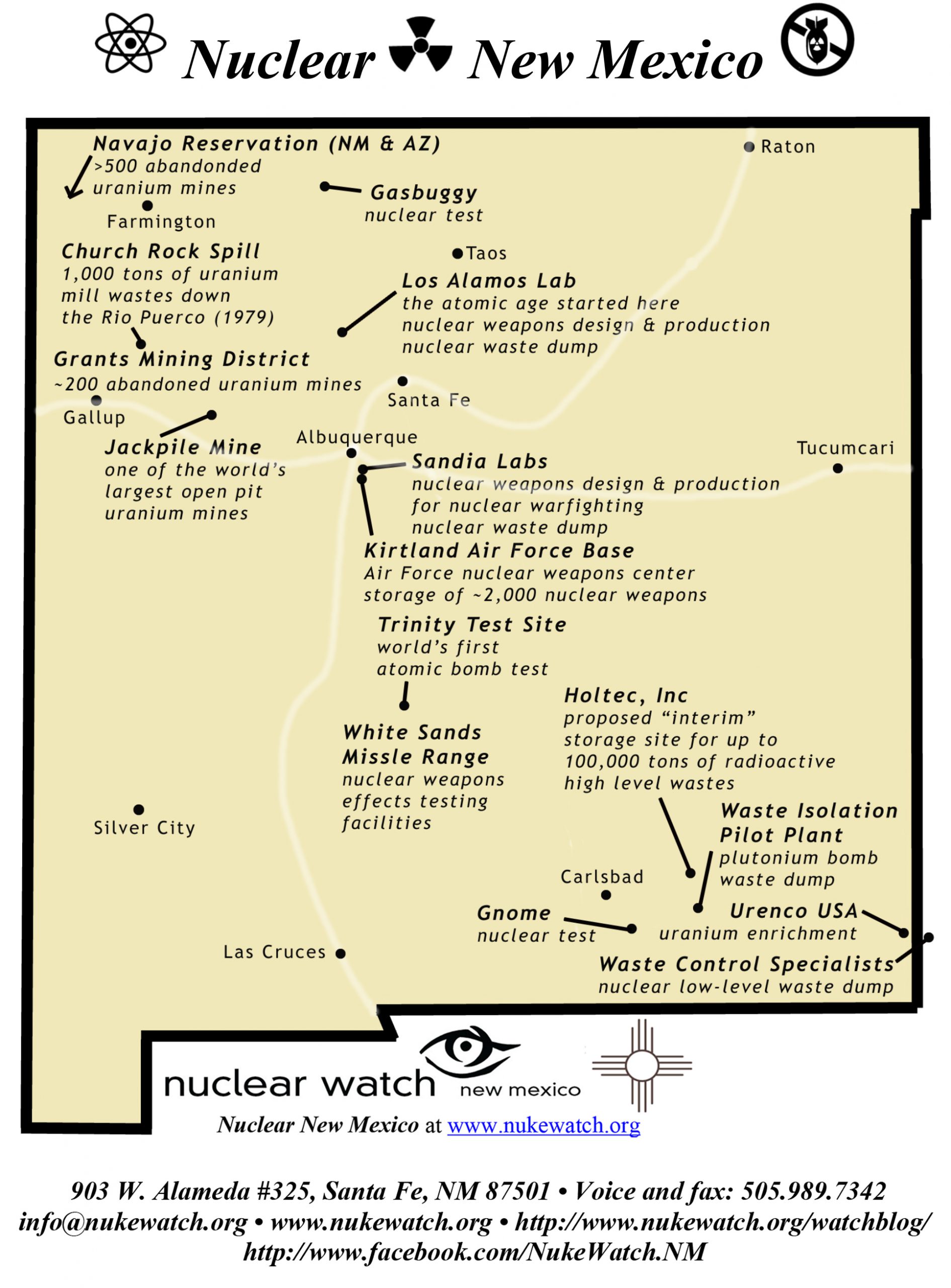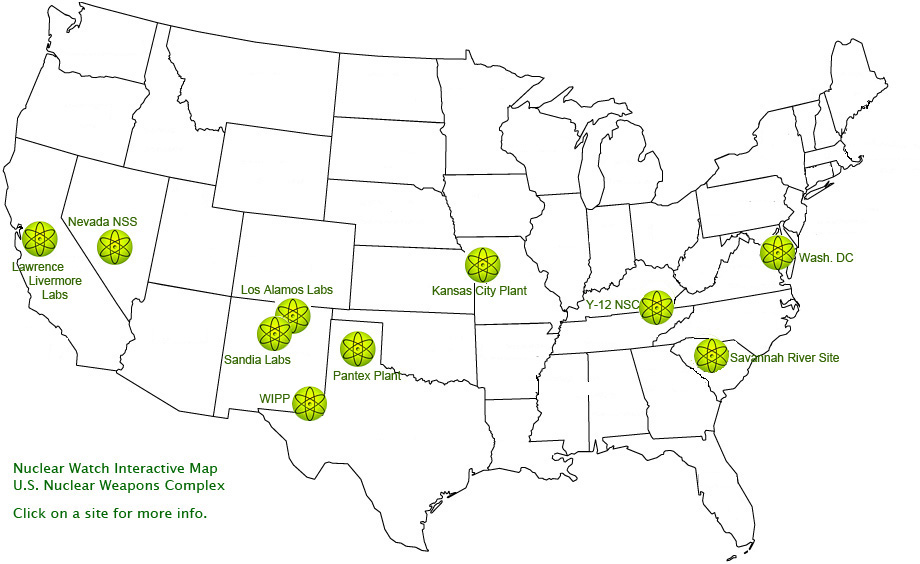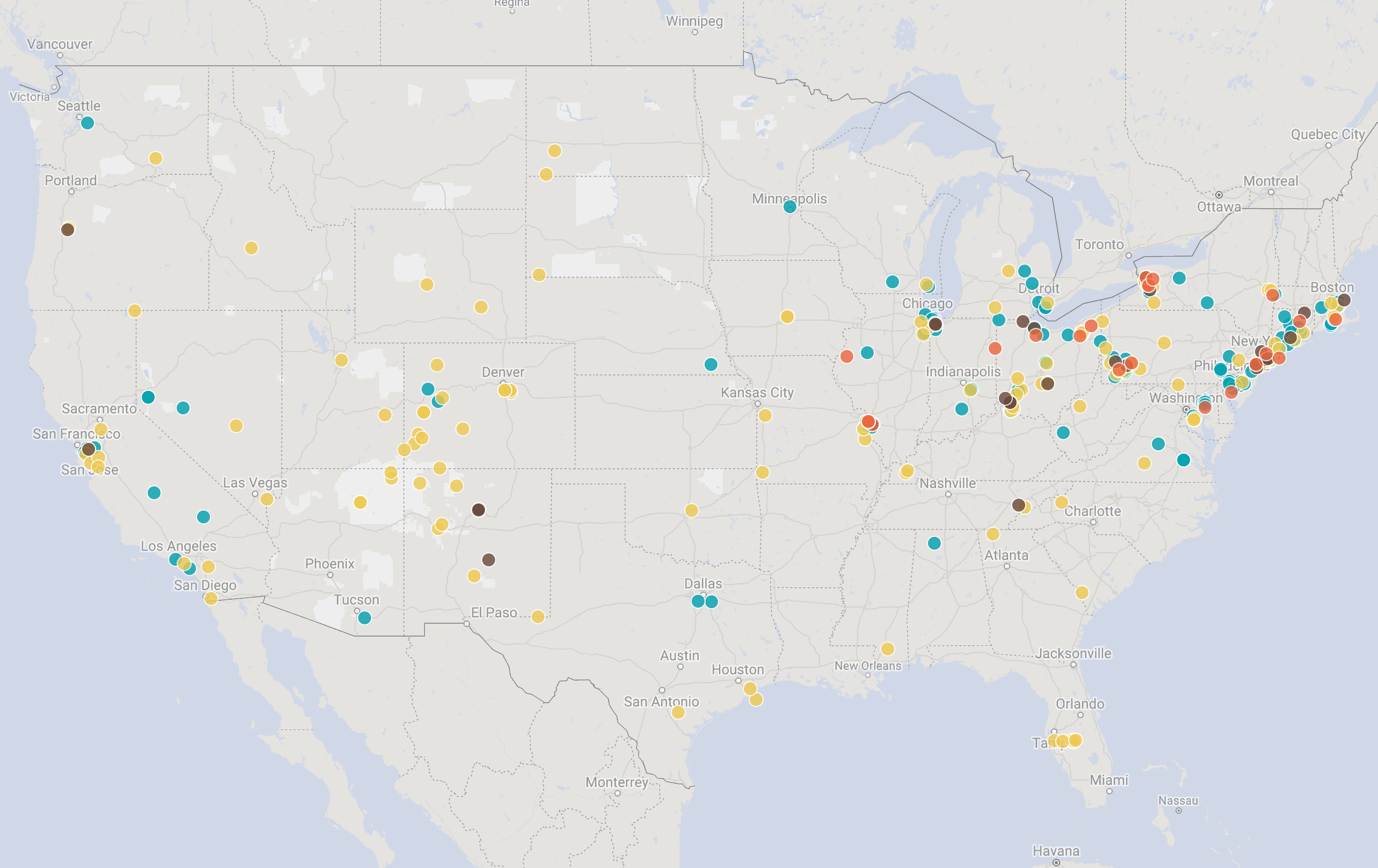QUOTE OF THE WEEK
Nothing Found
It seems we can’t find what you’re looking for. Perhaps searching can help.
LANL’s Central Mission: Los Alamos Lab officials have recently claimed that LANL has moved away from primarily nuclear weapons to “national security”, but what truly remains as the Labs central mission? Here’s the answer from one of its own documents:
LANL’s “Central Mission”- Presented at: RPI Nuclear Data 2011 Symposium for Criticality Safety and Reactor Applications (PDF) 4/27/11
Banner displaying “Nuclear Weapons Are Now Illegal” at the entrance in front of the Los Alamos National Lab to celebrate the Entry Into Force of the Nuclear Weapon Ban Treaty on January 22, 2021
Nothing Found
It seems we can’t find what you’re looking for. Perhaps searching can help.
Follow the Money!
Map of “Nuclear New Mexico”
Nuclear Watch Interactive Map – U.S. Nuclear Weapons Complex
In 1985, US President Ronald Reagan and and Russian President Mikhail Gorbachev declared that “a nuclear war cannot be won and must never be fought.”
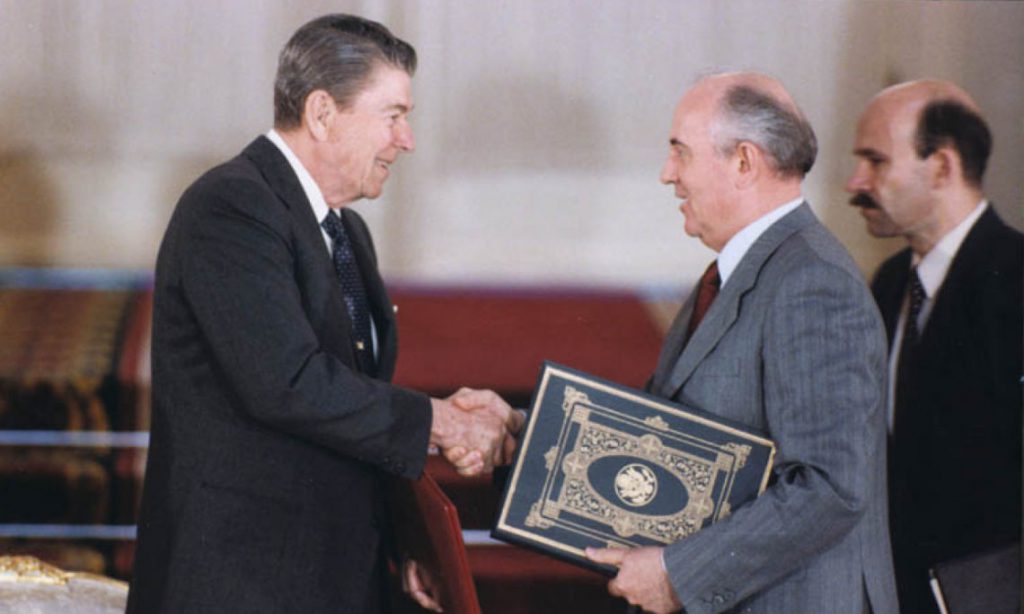
Waste Lands: America’s Forgotten Nuclear Legacy
The Wall St. Journal has compiled a searchable database of contaminated sites across the US. (view)
Related WSJ report: https://www.wsj.com
2022 BLOG POSTS
Nothing Found
It seems we can’t find what you’re looking for. Perhaps searching can help.
New & Updated
Energy Dept Misrepresents Cost and Scope of Los Alamos Cleanup
New Mexican Politicians Should Not Be Misled
Energy Dept Misrepresents Cost and Scope of Los Alamos Cleanup
Santa Fe, NM – The Department of Energy (DOE) has released a 2016 Lifecycle Cost Estimate Summary of proposed future cleanup at the Los Alamos National Laboratory (LANL). At the beginning of that document DOE declares that “An estimated 5,000 cubic meters of legacy waste remains, of which approximately 2,400 cm [cubic meters] is retrievably stored below ground”, a claim which was widely reported in New Mexican media. From there DOE estimates that it will cost $2.9 to $3.8 billion to complete so-called cleanup around 2040.
The public was notified of the 2016 Lifecycle Cost Estimate in a September 15 Santa Fe City press release, with the subtitle “Study Lays Out Timeline, Costs, and More, Answers Critical Questions with Honest Assessment.” Santa Fe Mayor Javier Gonzales is quoted, “This report represents the first and most comprehensive release of specific plans to complete the cleanup of legacy waste at LANL, and is a big step forward for the people in these communities who want to see a concrete commitment to making progress.” Mayor Gonzales went on to thank Senators Udall and Heinrich and Rep. Ben Ray Lujan for their help in obtaining the report.
However, the DOE report is far from honest. It intentionally omits any mention of approximately 150,000 cubic meters of poorly characterized radioactive and toxic wastes just at Area G (LANL’s largest waste dump) alone, an amount of wastes 30 times larger than DOE acknowledges in the 2016 Lifecycle Cost Estimate. In reality, DOE and LANL plan to not clean up Area G, instead installing an “engineered cover” and leaving the wastes permanently buried. This will create a permanent nuclear waste dump above the regional groundwater aquifer, three miles uphill from the Rio Grande. Radioactive and toxic wastes are buried directly in the ground without liners, and migration of plutonium has been detected 200 feet below Area G’s surface.
Santa Fe Mayor Gonzales is the Vice-Chair of the Regional Coalition of LANL Communities. The Coalition is comprised of elected official from eight cities, counties and pueblos surrounding LANL, and is overwhelmingly funded by DOE and Los Alamos County. The same Santa Fe City press release quotes the RCLC Executive Director, “The Lifecycle Baseline documentation provides our communities the necessary foundation to properly advocate on behalf of the best possible scenarios for cleaning up legacy nuclear waste at the Laboratory in the most time and cost-efficient manner. After years of requests for this document, we now have the tool that can get us to additional cleanup dollars to get the job done.”
However, the 2016 Lifecycle Cost Estimate Summary itself states that it is “based on realistic expectations of annual funding for the remaining work” (last page, unnumbered) and “annual funding is expected to remain constant throughout the duration of the cleanup mission” (p. 5). While annual funding for the Lab’s nuclear weapons programs has climbed to $1.5 billion, cleanup has fallen from a high of $225 million in FY 2014 to $189 million requested for FY 2017. Moreover, this trend of declining cleanup funding may be exacerbated by the planned trillion dollar “modernization” of U.S. nuclear forces, including research and production sites like LANL (which is slated to quadruple production of the plutonium pit triggers for nuclear weapons). Instead of being a tool for additional dollars for genuine, comprehensive cleanup, the 2016 Lifecycle Cost Estimate Summary is a DOE ploy to avoid cleaning up more than 90% of all wastes at LANL.
Jay Coghlan, Nuclear Watch New Mexico Executive Director, commented, “Mayor Gonzales and the Regional Coalition are to be commended for getting any Lab cleanup plan at all out of the Department of Energy. But now they should take the next step and get the Department of Energy to quit being so chintzy with cleanup. Our elected officials should demand that DOE retract its false claim that there is only 5,000 cubic meters of waste left at LANL to clean up. Then our politicians should push hard for a genuine, comprehensive cleanup plan that permanently protects the environment and our precious water resources while creating hundreds of high paying jobs.”
# # #
The Department of Energy’s 2016 Lifecycle Cost Estimate Summary is available at https://nukewatch.org/importantdocs/resources/LBC-Summary-Aug-2016.pdf
Estimated quantities of waste at Area G (in cubic yards) are from Table G3.41, MDA G Corrective Measures Evaluation, 2011, LANS, p. G-13. See excerpts at https://nukewatch.org/importantdocs/resources/Area_G_Pit_Totals_from_CME_rev3_Sept-2011.pdf
The full MDA G Corrective Measures Evaluation (159 MB) is available at http://permalink.lanl.gov/object/tr?what=info:lanl-repo/eprr/ERID-206324
Documentation of the plutonium detection 200 feet below the surface of Area G is at https://nukewatch.org/importantdocs/resources/AGCME Plate_B-3_radionuclides_subsurface.pdf

New Mexican Politicians Should Not Be Misled- Energy Dept. Misrepresents Cost and Scope of Los Alamos Cleanup
Santa Fe, NM
“…The DOE report is far from honest. It intentionally omits any mention of approximately 150,000 cubic meters of poorly characterized radioactive and toxic wastes just at Area G (LANL’s largest waste dump) alone, an amount of wastes 30 times larger than DOE acknowledges in the 2016 Lifecycle Cost Estimate. In reality, DOE and LANL plan to not clean up Area G, instead installing an “engineered cover” and leaving the wastes permanently buried. This will create a permanent nuclear waste dump above the regional groundwater aquifer, three miles uphill from the Rio Grande. Radioactive and toxic wastes are buried directly in the ground without liners, and migration of plutonium has been detected 200 feet below Area G’s surface…”
New Mexican Politicians Should Not Be Misled- Energy Dept. Misrepresents Cost and Scope of Los Alamos Cleanup
Santa Fe, NM
The Department of Energy (DOE) has released a 2016 Lifecycle Cost Estimate Summary of proposed future cleanup at the Los Alamos National Laboratory (LANL). At the beginning of that document, DOE declares that “An estimated 5,000 cubic meters of legacy waste remains, of which approximately 2,400 cm [cubic meters] is retrievably stored below ground”, a claim which was widely reported in New Mexican media. From there DOE estimates that it will cost $2.9 to $3.8 billion to complete so-called cleanup around 2040.
DOE Secretly Funding Front Group to Help it Evade Nuclear Cleanup
FOR IMMEDIATE RELEASE: August 31, 2016
Contact: Denise Duffield, 213-689-9170 <tel:213-689-9170> office
Cindi Gortner 818-489-1226
Bonnie Klea 818-854-4825
Marie Mason 805-279-0356
U.S. Department of Energy Secretly Funding Front Group to Help it Evade Nuclear Cleanup at Santa Susana Field Laboratory
Controversial grant made at the same time department reneged on financial commitment to national independently administered community fund
Community members living near the contaminated Santa Susana Field Laboratory were outraged to learn that the U.S. Department of Energy (DOE) has secretly been funding a front group that is lobbying for the breach of DOE’s cleanup agreement for the Santa Susana Field Laboratory (SSFL) – and that the agency’s request for secrecy may have been made to avoid attention from Senator Barbara Boxer, a longtime supporter of full cleanup.
SSFL is heavily contaminated with nuclear and chemical contamination resulting from decades of nuclear activities and rocket engine testing, In 2010, agreements (Administrative Orders on Consent or AOCs) were signed between the state Department of Toxic Substances Control (DTSC) and DOE and NASA to cleanup all detectable contamination at their respective portions of the property. The AOC was first proposed by former DOE Secretary Dr. Steven Chu and Assistant Secretary for Environmental Management (DOE-EM) Dr. Inez Triay. Boeing, which owns most of the site, refused to sign the agreement and is pushing for a much weaker cleanup.
In 2011, under the Brown Administration, the DTSC’s commitment to full cleanup began to erode, and along with it, those of NASA and DOE. Over objections from community members and elected officials , the DTSC replaced the longstanding public participation vehicle, the SSFL Work Group, with the SSFL Community Advisory Group (SSFL CAG). The CAG’s leadership is composed of individuals with ties to the parties responsible for the contamination at SSFL, and the group actively lobbies against the AOCs. One CAG flyer reads, “Why the AOC Cleanup at SSFL is Bad for Our Community” (here .) and states that the AOC will harm the environment and Native American artifacts, which are in fact protected by the AOC. The CAG also denies SSFL’s health impacts. One CAG member, a former SSFL official and current DOE contractor, maligned previous health studies so badly that their authors felt compelled to write an op-ed in the Ventura County Star in defense.
The public has been demanding to know for a long time how the CAG was funded, and neither the CAG nor DTSC have disclosed that information. In December 2015 and in May 2016 , cleanup advocates complained to the DTSC Independent Review Panel (IRP), established by the California legislature to investigate DTSC’s many failings, about the CAG’s anonymous funding and conduct. No action was taken on the matter.
The complaints were instigated by the CAG’s announcement, at it’s August 19, 2015 meeting, that it would be receiving a $32,000 – $35,000 donation from a donor who wished to be anonymous. A video from the meeting shows CAG member Alec Uzemeck claiming the donation had “no strings,” and that it was anonymous “Because everything we do is politically charged. We have people out there who make phone calls. And if you’re the executive of a corporation and you get a call from Barbara Boxer, I’m quite sure that that’s going to have an impact on it. But, we don’t want that. We wanna have the money in hand when we announce who the donors are.” (See video here .) The CAG’s August 2015 minutes (here ) make it clear that the anonymity was at the donor’s request, and so secret that the CAG leadership would not reveal the donor to the full CAG membership, causing one CAG member to resign.
At it’s August 17, 2016 meeting, a full year after having announced its anonymous gift, the CAG revealed that the donor was the Department of Energy. Uzemeck said, “DOE will be coming out with a quarterly report, probably in two or three weeks. And it will have a list of grants on the last page. And DOE is the one that made the grant for us. They are the one who supplied the funding. So, the question’s been answered.” Uzemeck’s statement can be viewed here. The CAG’s tax returns show that the organization received $38,600 in 2015.
The DOE refuses to answer questions about the arrangement, what the grant funds are expended on, explain why the funding was kept secret for a full year, or provide a copy of the grant application and contract. “For one of the Responsible Parties, DOE, to be funding a group that is trying to help DOE avoid its cleanup obligations, and asking for DOE’s identity as the source of the funds to be long kept secret, would be nothing short of scandalous.” said Denise Duffield, Associate Director of Physicians for Social Responsibiiity-Los Angeles in an August 30 email to Dr. Monica Regalbuto, Assistant Secretary for the DOE’s Office of Environmental Management.
Community members are also deeply troubled that DOE funded the CAG during the same month that it broke its commitment and revoked funding for the final year of a five-year commitment to the New Mexico Community Foundation (NMCF)-administered Community Involvement Fund (CIF), which funds independent groups in impacted communities near contaminated DOE sites throughout the country. Reneging on its contract and failing to disperse a final $300,000 payment to NMCF caused over a dozen community groups to lose key funding.
“DOE broke its commitment to provide its funding for community groups near contaminated sites through an independent mechanism and hands-off procedures that assured DOE would not do precisely what it has now done—fund a front group to lobby on DOE’s behalf to get out of its cleanup obligations.” said Duffield in the email to Regalbuto.
Community members are dismayed and angered by the revelations. Simi Valley resident Marie Mason, who has led community cleanup efforts for 28 years, said, “I find it more than shocking that the DOE would fund this group and ask to conceal they are the funding source and especially to not have Senator Boxer find out. I am more than disgusted and filled with sadness. DOE and DTSC are part of the problem with too many close ties to the polluters and total disregard for the communities they are supposed to protect.”
Bonnie Klea, a former worker at SSFL and cancer survivor, said, “I am appalled that DOE funded the CAG so that members can go out and lobby against the AOC and deny the cancer risks from the past, present and future exposure from the site. This is disgusting. ” Klea and others note that the CAG does not represent the views of the community, which overwhelming supports the AOCs. All but 14 of the 3,700 comments submitted on the AOC were in favor of the agreement, and over 1,600 signed a petition last year urging that the cleanup agreements be upheld. (See petition here .)
Duffield’s email to DOE, sent also to local and state officials, implored the agency for answers and noted that no local elected officials had been consulted with or informed of the funding. “The community has the right to know about the intent, character, and tactics of the agency that holds their potential health and well being in its hands. And elected officials, many of whom have been lobbied by the CAG to weaken the cleanup, must be informed about financial contributions that DOE is making to this group to influence them and help it break out the cleanup agreements.”
# # #
The Rocketdyne Cleanup Coalition, or RCC, is a community-based alliance dedicated to the cleanup of the Santa Susana Field Laboratory (SSFL), commonly known as Rocketdyne.
From: Denise Duffield <dduffield(at)psr-la.org>
Date: Mon, Aug 29, 2016 at 12:57 PM
Subject: Time-Sensitive Request re: DOE CAG funding and the SSFL AOC cleanup agreement
To: monica.regalbuto@em.doe.gov
Dear Assistant Energy Secretary for Environmental Management Regalbuto:
I was shocked to learn recently that DOE has been funding a front group that is lobbying for the breach of DOE’s cleanup agreement for the Santa Susana Field Laboratory (SSFL) – and that DOE had apparently requested that the funding be kept secret so that Senator Barbara Boxer wouldn’t learn of it. I write today to both apprise you of this troubling situation and to request further information and documents related to DOE’s decision to fund the SSFL CAG.
The SSFL CAG is a small but highly controversial group that is lobbying against the cleanup agreement (Administrative Order on Consent, or AOC) for SSFL signed by both DOE and the state regulatory agency overseeing the cleanup, the Department of Toxic Substances Control (DTSC). For example, one CAG flyer reads, “Why the AOC Cleanup at SSFL is Bad for Our Community” (here.) “The AOC Cleanup: More Harm Than Good?” reads another (here.) The CAG routinely propagates false information about SSFL’s contamination, health impacts, and cleanup. A CAG – Community Advisory Group – should represent the community. However, the SSFL CAG does not even remotely represent the community, which understands that SSFL is contaminated with dangerous radionuclides and chemicals and needs to be fully remediated per the current DOE cleanup agreement. The CAG is a classic “astroturf” (i.e., fake grassroots) group dominated by people with ties to the parties responsible for the contamination at SSFL.
The public has been demanding to know for a long time how the CAG was funded and how it spends those funds. The CAG has refused to disclose that information, which is troubling for an entity that claims to be public. The community has suspected that the money comes from one or more of the entities that polluted the site and that is trying to get out of its cleanup obligations, and that that is why the CAG wouldn’t disclose the funding source or sources. Now it appears that that is indeed the case. For one of the Responsible Parties, DOE, to be funding a group that is trying to help DOE avoid its cleanup obligations, and asking for DOE’s identity as the source of the funds to be long kept secret, would be nothing short of scandalous.
The DOE SSFL cleanup agreement (AOC) was proposed by former DOE Secretary Dr. Steven Chu and Assistant Secretary for Environmental Management (DOE-EM), Dr. Inez Triay. It was signed by DOE and DTSC in December 2010. The AOC stipulates that Area IV and the Northern Buffer Zone at SSFL are to be cleaned up to background. In February 2014, at a meeting of the SSFL Work Group, DOE SSFL Project Director John Jones told the audience of community members, elected officials, and media that the DOE was committed to upholding the AOC agreement (see video here.)
Since then, the community has seen an erosion of DOE’s stated commitment, including a Public Scoping plan which included numerous options that would violate the AOC (such as keeping waste on site), accompanied by a report grossly exaggerating soil removal estimates (see statement by the Southern California Federation of Scientists here.) In addition, the AOC explicitly defines soils as including structures (see page five of AOC here), which are to be cleaned up to background and all wastes to go to licensed low level radioactive waste disposal sites, yet DOE is now taking the position that it can demolish nuclear structures at SSFL at will, using far less protective standards, and dispose of their radioactive wastes anywhere. The DOE has also apparently told the CAG that it is contemplating trying to modify the AOC to be required to perform much less cleanup than it had promised in order to save money (see CAG July 20, 2016 minutes here.)
And now, we have learned that the DOE has been funding the CAG. The DOE is abundantly aware that the CAG openly, actively, and vigorously works to break the AOC cleanup agreement that DOE signed. DOE’s funding of the SSFL CAG is therefore an alarming and direct assault on the AOC itself. It also makes clear that the CAG is an agent of one of the parties responsible for the pollution at the site and which is trying desperately to get out of its obligation to clean up all the radioactive and toxic mess that it made. The CAG regularly lobbies elected officials to try to persuade them to push to weaken the cleanup —an activity outside the scope of a regular community advisory group. It is very troubling for DOE, responsible for the contamination and sworn to uphold a cleanup agreement to clean it all up, to be secretly funding a group that lobbies elected officials to support DOE breaking its agreement.
We are also deeply disturbed by the secrecy surrounding DOE’s grant to the SSFL CAG. The CAG first announced that it was to receive $32,000 in funding at an August 2015 meeting, in which it stated that the donor wished to remain anonymous in order to avoid Senator Barbara Boxer, a longtime SSFL cleanup supporter, learning of the funding and taking action thereon. (See video of CAG meeting here.) Only now, a year later, near the end of Senator Boxer’s esteemed Senate career, has the CAG apparently been given permission to reveal that the identity of its funder is the DOE. It is outrageous and unconscionable for a government agency to make a financial contribution to any organization and request that the funding be kept secret, for any reason, let alone for the purpose of evading the attention of a United States Senator who would likely object to what it was doing. The CAG’s August 2015 minutes (here) make it clear that the anonymity, which lasted a full year, was at the donor’s request.
Further, the DOE funded the CAG during the same year that it broke its commitment and revoked funding for the final year of a five-year commitment to the New Mexico Community Foundation (NMCF)-administered Community Involvement Fund (CIF), which funds independent groups in impacted communities near contaminated DOE sites throughout the country. The DOE’s agreement with NMCF states, “By utilizing a cooperative agreement with an independent entity to distribute grant funds to qualified organizations representing the interests of the public, DOE-EM will ensure that the program is not viewed as a surrogate for DOE’s own preferences, and that long-term DOE-EM decisions are based on input from individuals and/or groups who are most likely to be affected by those decisions.”
In other words, DOE was supposed to stay out of the grant selection process to assure that groups funded were independent of DOE. However, the DOE weighed in heavily against a re-application submitted by Physicians for Social Responsibility-Los Angeles (PSR-LA) for the SSFL Work Group, the longstanding advisory group established a quarter of a century ago by the electeds and which represents the main mechanism for the community to learn about and provide feedback on the cleanup and hold the agencies accountable. In August 2013 we applied for and received a $23,000 CIF grant. We re-applied in August 2014, but learned that DOE was pressuring CIF to deny the grant, which violated its commitment to keep hands-off the selection process. To its credit, in November 2014, the NMCF awarded the second grant of $20,000 (and did not fund the SSFL CAG, which had also applied for the funding.)
Very shortly thereafter, the DOE reneged on the final $300,000 it had pledged to NMCF, impacting not just PSR-LA and the SSFL Work Group but over a dozen communities nationwide. NMCF sent a message to its grantees on March 16, 2015 stating, “Earlier this year, representatives of the Department of Energy (DOE) advised New Mexico Community Foundation (NMCF) that the foundation would receive only partial funding for the CIF grant program in 2015. Last month, we were informed that NMCF would only be funded a small portion of the overall budget request solely for administrative oversight of the current 2014-15 grant cycle, and no funding would be allocated to go towards new grant-making. Adding to our confusion and concern, the decision-making process associated with the 2015 CIF appropriation has not been clearly communicated, nor have we been given a clear indication of the reasons for the reduction in funding.”
We cannot say with certainty that DOE revoked funding to the NMCF due to its decision to fund the SSFL Work Group despite the inappropriate pressure by DOE. But, we must point this out as a strong possibility in light of the timing and DOE actions described herein. The CIF grant enabled the return of the trusted public participation vehicle, the SSFL Work Group, which attracted capacity crowds who were able to learn about the contamination that would be left on site if the cleanup agreements were not upheld. DOE had participated in the SSFL Work Group since its inception, but has now stopped attending virtually any public meeting where it could be held to account for its actions. Regardless of DOE’s motivation to abrogate its agreement with NMCF, it is very troubling that the DOE made this decision while simultaneously funding an organization that opposes a cleanup agreement that the DOE has been strongly signaling it wants to break. DOE broke its commitment to provide its funding for community groups near contaminated sites through an independent mechanism and hands-off procedures that assured DOE would not do precisely what it has now done—fund a front group to lobby on DOE’s behalf to get out of its cleanup obligations.
It is difficult to overstate just what is at stake for communities near SSFL right now. Decades of nuclear and aerospace activities at SSFL have left a legacy of dangerous nuclear and chemical contamination that continues to migrate from the site to offsite populations. Federal studies have shown an increase in cancers associated with proximity to the site. In 2010, after decades of attempts to achieve full cleanup, the historic AOCs were signed. As a result, $41.5 million dollars were spent for a US EPA survey that identified background radiation and found nearly 500 samples, in just one area of SSFL, that were above background, in some cases dramatically so. The community eagerly anticipated full cleanup, which the AOC stipulated would be complete by 2017.
We are now just months away from 2017, but cleanup has yet to begin. Indeed, DOE’s draft EIS – which a court ordered a decade ago and was due to be published years ago – is not yet released. Community members have feared that DOE’s EIS would be a full-bodied attack on the very cleanup agreement DOE had sworn to carry out, and wondered if the EIS was being delayed so as to not come out until after Senator Boxer leaves office and can no longer take action to insist DOE live up to the promises made. This suspicion has only increased given the timing of the announcement that DOE is the CAG’s secret benefactor, and that the reason for the secrecy was to avoid attention from Boxer. The community is appalled and angry, and deserves to know the full details of DOE’s arrangement with the SSFL CAG.
Below please find background information and documentation on these matters, followed by a series of pressing questions. I request that DOE provide answers to the questions, as well as a copy of the SSFL CAG Foundation’s grant application/proposal to the DOE and its DOE grant/contract, as well as any grant report, immediately. If there has been more than one grant to the CAG, provide information about each. The community has the right to know about the intent, character, and tactics of the agency that holds their potential health and well being in its hands. And elected officials, many of whom have been lobbied by the CAG to weaken the cleanup, must be informed about financial contributions that DOE is making to this group to influence them and help it break out the cleanup agreements. DOE funding a front group to lobby elected officials to push them to support DOE breaking its cleanup agreements would be an outrage.
Background and Documentation
The SSFL CAG was formed in 2012 over the objections of longtime community members and local elected officials. (See community petition here and letter from elected officials Julia Brownley, Fran Pavley, Shelia Kuehl, Linda Parks, and Greig Smith opposing formation of the CAG and supporting instead the longstanding SSFL Work Group here.) The CAG is widely perceived as a front group for the polluters that does not represent the interests of the community, because it is opposes the cleanup agreements that are overwhelming supported by the community. All but a handful of the 3,700 comments submitted on the AOC were in favor of the agreement. Last year over 1,600 signed a petition urging that the cleanup agreements be upheld. (See petition here.) Yet every member of the CAG opposes the AOCs, despite the requirements that a CAG represent the range of community perspectives.
The CAG’s leadership is composed of individuals who are former employees or contractors of the parties responsible for cleaning up the site (Boeing, DOE, and NASA.). Alec Uzemeck worked for Boeing’s predecessor, North American Aviation, at its then-headquarters in Downey for which the Santa Susana site was the field lab. Brian Sujata was Boeing’s project manager for SSFL cleanup, while Boeing was DOE’s contractor for the cleanup. Ross Berman worked for both Tetra Tech and CH2M Hill, contractors for the responsible parties. And Abe Weizberg was an official at SSFL, in charge of safety for the SNAP reactors, one of which experienced 80% fuel damage in an accident. Weitzberg remains a consultant for the DOE.
Since its founding, the SSFL CAG has undertaken a multi-faceted campaign aimed at undoing the SSFL cleanup agreements. This includes exaggerating cleanup soil volumes and truck traffic and claiming that the cleanup will harm the site’s natural environment and Native American artifacts (which are in fact protected by the AOC.) The CAG also attempts to minimize the contamination at SSFL and health impacts. Last year, CAG member and former SSFL official Weitzberg launched an effort to have the Agency for Toxic Substances and Disease Registry (ATSDR) refute prior health studies and weigh in against the cleanup. In the process, he maligned the authors of those studies, who expressed their objections in an article published in the Ventura County Star here. The CAG has also made a habit of regularly and publicly disparaging longtime community members and cleanup advocates. Whereas meetings of the longstanding SSFL Work Group are packed with concerned members of the public and representatives of elected officials, very few attend CAG meetings. The last meeting had only half a dozen CAG members and a roughly equal number of the public, most of whom were critics of the CAG’s biases and actions.
On August 19, 2015, CAG member Alec Uzemeck announced at an SSFL CAG meeting that the CAG would be receiving a $32,000 – $35,000 donation from a donor who wished to be anonymous. The minutes from the meeting (which can be viewed here) state that the CAG established a non-profit foundation, “…in response to the gift from a donor who wishes to remain anonymous.” The CAG leadership was so secretive about the donor’s identify that it refused to inform the full CAG membership, causing one CAG member to resign, as reflected in the minutes, ” As a result of the fact that the donor is anonymous, Elizabeth Harris has resigned from the CAG…” At the meeting, Uzemeck repeatedly said that the donation had “no strings,” and of the gift said, “Why is it anonymous at this point? Because everything we do is politically charged. We have people out there who make phone calls. And if you’re the executive of a corporation and you get a call from Barbara Boxer, I’m quite sure that that’s going to have an impact on it. But, we don’t want that.” (See video here.)
In December 2015 and in May 2016, cleanup advocates and community members complained to the DTSC Independent Review Panel (IRP), established by the California legislature to investigate DTSC’s many failings, about the CAG’s anonymous funding and conduct (see paragraphs 4 -6 on page 2 of the IRP’s May 12, 2016 minutes here.)
Finally, at an SSFL CAG meeting on August 17, 2016, nearly a year after announcing the funding and the donor’s request that its identity be kept secret so as to keep Senator Boxer in the dark, Uzemeck announced, “DOE will be coming out with a quarterly report, probably in two or three weeks. And it will have a list of grants on the last page. And DOE is the one that made the grant for us. They are the one who supplied the funding. So, the question’s been answered.” A recording of Uzemeck’s statement can be viewed here.
The SSFL CAG’s tax returns, which can be viewed here, show that the organization received $38,600 in 2015.
Questions for the Department of Energy
1. Did DOE, as reflected in the CAG’s minutes, suggest to the SSFL CAG to form a non-profit foundation so that it could provide funding to the CAG?
2. When did DOE begin discussing funding the CAG? When did it actually make the contribution, and what was the amount of the gift? Has there been more than one?
3. What is the stated purpose of the grant? What will/have grant funds be expended on?
4. Under what category of funding was this grant made? Was it made from the DOE Office of Environmental Management, the same office that reneged on its commitment to NMCF?
5. CAG member Alec Uzemeck repeatedly stated that the grant had “no strings.” Does the DOE grant have any restrictions? Is lobbying prohibited? Is the CAG required to submit a report on its activities? Will it be invited to reapply for funding again this year?
6. Why did DOE request that its gift to the CAG be anonymous? Did the DOE tell the CAG, as expressed by Alec Uzemeck, verbally or in writing, that it wanted its gift secret, at least for a time, because it wanted to avoid repercussions from Senator Barbara Boxer?
7. How does the DOE reconcile public statements that it will uphold the AOC at the same time that it is funding a group that overtly works to destroy the AOC?
8. Did DOE’s animosity toward the Santa Susana cleanup agreement, and its displeasure at CIF funding PSR-LA and the SSFL Work Group, cause it to cancel the last year of its funding to NMCF, and thus cost over a dozen community groups throughout the United States to lose funding?
9. Did DOE consult with elected officials historically concerned about SSFL cleanup as to whether the grant should be given to the CAG and whether it was a legitimate group representing the community? Why did DOE ignore the opposition to the CAG expressed, in writing, by the electeds?
10. Why did DOE not publicly solicit grant applications instead of secretly arranging to give the money to the CAG? Why did DOE not solicit a grant application from the longstanding SSFL Work Group established by the electeds, which supports the cleanup agreements DOE is supposedly sworn to uphold? Given that very few people attend CAG meetings, and the Work Group meetings are often standing-room only, why did DOE secretly fund the CAG, without a competitive grant application process, and not solicit an application from SSFL the Work Group?
Again, in addition, I request that DOE provide a copy of the SSFL CAG Foundation’s grant application or proposal to DOE, as well as the DOE-SSFL CAG grant contract or agreement, immediately.
Sincerely,
Denise Duffield
Coordinator, SSFL Work Group
and
Associate Director, Physicians for Social Responsibility-Los Angeles
cc: Senator Barbara Boxer
Congresswoman Julia Brownley
California Senator Fran Pavley
LA County Supervisor Sheila Kuehl
Ventura County Supervisor Linda Parks
LA City Councilmember Mitch Englander
DTSC Director Barbara Lee
DTSC IRP Chair Gideon Kracov
DOE Inspector General report on the B61-12 nuclear smart bomb
The Department of Energy Inspector General has issued its audit report National Nuclear Security Administration’s Management of the B61-12 Life Extension Program. The B61-12 will literally cost twice its weight in gold. It is slated for production beginning 2020 and will blur the line between battlefield and strategic nuclear weapons by combining one strategic and three tactical variants. It will also be the world’s first “smart” nuclear bomb with a steerable tailfin kit giving it vastly improved accuracy. Nevertheless the U.S. government denies that the B61-12 will have any new military capabilities.
In its audit report, the DOE IG notes:
We believe without further improvement to its project management tools, it will be difficult for the program to proactively manage the costs, schedule, and risks of the B61-12 LEP to ensure it can deliver the First Production Unit within cost and meet its critical national security schedule. In addition, there is uncertainty whether the original cost estimate for the B61-12 LEP contains sufficient management reserve to allow the program to respond to the numerous risks identified in the program. Finally, not having documented assurance that unresolved significant finding investigations are a part of weapons design input significantly reduces management’s ability to ensure that redesigned nuclear weapon components have addressed prior safety and reliability concerns.
Regarding the last sentence “… reduces management’s ability to ensure that redesigned nuclear weapon components have addressed prior safety and reliability concerns”:
There was a problem with the new-design arming, firing and fuzing set for the W76-1, which is being produced now in its current Life Extension Program. It wasn’t a showstopper, but nevertheless a problem where new individual AF&F components had to be screened to determine whether their performance was affected.
The graph below from the 1993 Sandia Stockpile Life Study shows how the supermajority of nuclear weapons defects are discovered within the first few years of production. The point I’m reaching for is that as Life Extension Programs become more aggressive and more new-design components are used, design and production defects will be inevitable. It would be far better to maintain the stockpile through a conservative curatorship approach.
Circa 1995 I met with DOE Asst. Sec. for Defense Programs Victor Reis, the so-called father of the Stockpile Stewardship Program. Reis explicitly told me that the exorbitant Stockpile Stewardship Program was all about “the other side of the bathtub curve,” meaning it’s all about accelerated defects showing up at some time due to aging. Guess what? It hasn’t happened, not with ongoing surveillance and maintenance and exchange of limited life components that have been almost routine for decades. As the 1993 Sandia Stockpile Life Study concluded,
“It is clear that, although nuclear weapons ages, they do not wear out; they last as long as the nuclear weapons community (DOE and DOD) desire. In fact, we can find no example of a nuclear weapon retirement where age was ever a major factor in the retirement decision.”
Since then, the 1993 Sandia Stockpile Life Study’s conclusion has been buttressed by the JASON’s 2006 Pit Life Study and 2009 Life Extension Programs Study. In short, Life Extension Programs are not necessary for maintaining the nuclear stockpile, and may in fact undermine reliability by intentionally introducing major changes to an extensively tested stockpile. Life Extension Programs are, however, essential for creating new military capabilities for existing nuclear weapons, which is pretty clearly demonstrated by the B61-12 about to go into production, and arguably the W76-1 as well.

NNSA Set to Approve New Facilities for Expanded Plutonium Pit Production Without Credible Plans and Required Public Review
August 10, 2016
Santa Fe, NM – Yesterday, on the 71st anniversary of the destruction of Nagasaki by a plutonium bomb, the Government Accountability Office (GAO) submitted a report to the Senate Armed Services Committee on the National Nuclear Security Administration’s (NNSA’s) plans to expand plutonium pit production at the Los Alamos National Laboratory. NNSA has scheduled a formal “Critical Decision 2” at the end of this coming September to proceed with preliminary design of the upgraded and new facilities necessary to expand plutonium pit production.
The NNSA is a semi-autonomous nuclear weapons agency within the Department of Energy, which has the singular distinction of being the only federal department on the GAO’s High Risk List for wasting taxpayer’s dollars for 25 consecutive years. LANL is NNSA’s so-called “Plutonium Center of Excellence” and the nation’s only site for pit production, but major operations at PF-4, its main plutonium facility, have been stopped since June 2013 because of nuclear criticality safety concerns. In addition, there is no place for LANL to send its radioactive transuranic wastes from plutonium pit production since one of its waste drums ruptured at the Waste Isolation Pilot Plant in February 2014 and indefinitely closed that multi-billion facility.
Despite all this, funding for NNSA’s nuclear weapons research and production programs is being increased to nearly double the Cold War’s historic average, while nonproliferation, warhead dismantlement and cleanup programs are being cut or held flat. This is in part due to plans to spend at least a trillion dollars over the next 30 years on completely rebuilding U.S. nuclear weapons and producing new missiles, subs and bombers to deliver them. The “modernized” U.S. nuclear force is expected to be operational until at least until 2080, more than a century after the 1970 NonProliferation Treaty’s mandate for global nuclear disarmament.
The GAO’s report found that NNSA’s plans for upgraded and new facilities to expand plutonium pit production to 50-80 pits per year “did not include key performance parameters” and lacked analysis of a full range of alternatives. LANL’s currently approved production level is up to 20 pits per year, sanctioned in a 1996 Stockpile Stewardship and Management Programmatic Environmental Impact Statement that was required under the National Environmental Policy Act (NEPA). Subsequent NEPA efforts by NNSA to formally approve expanded plutonium pit production at LANL failed, and new efforts to expand plutonium pit production without adequate NEPA coverage could be vulnerable to legal challenge. Additionally, there is no public explanation or justification for the need to expand to 50-80 pits per year other than the nuclear weaponeers saying so. In contrast, independent expert studies have shown that pits have reliable lifetimes of at least a century (the average age of pits in the stockpile is now around 31 years), and up to 20,000 plutonium pits are already stored at the Pantex Plant near Amarillo, TX.
In 2012, in the face of exploding costs and rising citizen opposition, NNSA cancelled an earlier proposal to build a Walmart-sized “Chemistry and Metallurgy Research Replacement (CMRR) Project-Nuclear Facility” for expanded plutonium pit production. Now, as an alternative, NNSA and LANL seek to raise the administrative limit on plutonium in the CMRR Project’s first phase, the newly constructed Radiological Lab, from an original 8.4 grams to 400 grams; upgrade PF-4, the Lab’s main plutonium facility; and proceed with a “Plutonium Modular Approach project.”
Raising the amount of plutonium in the Rad Lab to 400 grams allows for dramatically increased “materials characterization” and “analytical chemistry” in direct support of expanded plutonium pit production. But it also raises the Rad Lab from a “radiological facility” to a “Hazard Category 3” nuclear facility, which has never been done before. Planned gloveboxes and the existing ventilation system may have to change and the facility’s seismic safety rating re-examined. The Rad Lab was originally constructed and equipped for a total cost of $400 million, but now up to another $675 million in equipment is being added. On top of that, re-categorizing the Rad Lab to a Hazard Category 3 facility could cost another $365 million. In all, the Rad Lab can cost up to $1.5 billion, while upgrades to PF-4 will cost another billion.
The Plutonium Modular Approach involves building at least two and perhaps three underground “modules” at one billion dollars each or more. The GAO report notes how since NNSA narrowly defined the program requirement as building the modules themselves instead of examining the need for the modules, “there is effectively no project alternative other than the modular approach,” despite DOE’s own orders to complete an analysis of a full range of alternatives.
In all, according to the GAO report, the full CMRR alternative of upgrading the Rad Lab and PF-4 and building at least two modules would cost at least 4 billion dollars, compared to the CMRR”s previous price tag of $5.8 billion (which was up from $975 million in 2005), and this is before the usual cost overruns. The GAO report also notes how the CMRR alternative appears cheaper because non-nuclear weapons operations, such as preparing plutonium for NASA’s spacecraft battery packs, have been eliminated. NNSA’s pattern when faced with its own cost overruns is to cut out all but nuclear weapons production, as it did with the Uranium Processing Facility (UPF) near Oak Ridge, TN. When a Defense Department estimate put UPF construction at $19 billion (up from $6.5 billion), NNSA eliminated dismantlements and downblending of highly enriched uranium so that it could keep production of thermonuclear components that can kill millions.
Jay Coghlan, Nuclear Watch Director, commented, “Expanded plutonium pit production at LANL is not needed to maintain stockpile safety and reliability, but instead is a must for nuclear weaponeers who want to give existing weapons new military capabilities through so-called Life Extension Programs. This GAO report is more evidence of how taxpayers’ money could be far better spent than on poorly planned, unnecessary and very expensive expanded plutonium pit production.”
# # #
The GAO report NNSA Needs to Clarify Requirements for Its Plutonium Analysis Project at Los Alamos is available at
http://www.gao.gov/products/GAO-16-585?utm_medium=email&utm_source=govdelivery
DOE’s 25 year status on GAO’s High Risk list is documented at
http://www.gao.gov/highrisk/doe_contract_management/why_did_study
For an extensive history of successful citizen activism against plutonium pit production see
NNSA Set to Approve New Facilities for Expanded Plutonium Pit Production Without Credible Plans and Required Public Review
Santa Fe, NM
The National Nuclear Security Administration (NNSA) is a semi-autonomous nuclear weapons agency within the Department of Energy, which has the singular distinction of being the only federal department on the GAO’s High Risk List for wasting taxpayer dollars for 25 consecutive years. LANL is NNSA’s so-called “Plutonium Center of Excellence” and the nation’s only site for pit production, but major operations at PF-4, its main plutonium facility, have been stopped since June 2013 because of nuclear criticality safety concerns. In addition, there is no place for LANL to send its radioactive transuranic wastes from plutonium pit production since one of its waste drums ruptured at the Waste Isolation Pilot Plant in February 2014 and indefinitely closed that multi-billion facility.
Despite all this, funding for NNSA’s nuclear weapons research and production programs is being increased to nearly double the Cold War’s historic average, while nonproliferation, warhead dismantlement and cleanup programs are being cut or held flat…
LANL Estimate of $2.9 Billion for “Remaining” Cleanup Leaves Nuclear & Toxic Wastes Behind and Kills Needed Jobs
For immediate release July 28, 2016
LANL Estimate of $2.9 Billion for “Remaining” Cleanup
Leaves Nuclear & Toxic Wastes Behind and Kills Needed Jobs
Santa Fe, NM – The Department of Energy (DOE) has announced that the cost of “Remaining Legacy Cleanup” of radioactive and toxic wastes from more than 70 years of nuclear weapons research and production at the Los Alamos National Laboratory (LANL) will cost $2.9 billion through fiscal year 2035, averaging $153 million per year.
That cost estimate clearly assumes that the Lab’s major radioactive and toxic wastes dumps will not be cleaned up. Instead they will be “capped and covered,” leaving some 200,000 cubic yards of radioactive and toxic wastes at Area G, its largest waste dump. Those wastes sit in unlined pits and trenches, 800 feet above groundwater and three miles uphill from the Rio Grande (plutonium contaminants have been detected 200 feet below Area G). During this same period of time the Lab’s nuclear weapons programs that caused the mess to begin with will cost ten times as much, even before expected funding increases for expanded production of plutonium bomb core “pits” and increasingly aggressive “Life Extension Programs” that give existing nuclear weapons new military capabilities.
DOE’s announcement also pegs the cost of past cleanup at LANL at $3.2 billion to date, raising the question of what has been and will be accomplished with precious taxpayer dollars. The answer is not much for the money. According to DOE’s own data, for the next couple of years only around a sixth of LANL’s “cleanup” funding will actually go to cleanup. Approximately one-third will be used to catch up on worker pensions and another third to babysit improperly treated radioactive waste barrels, one of which ruptured and closed the multi-billion dollar Waste Isolation Pilot Plant. More than half of the remaining one-third for real cleanup goes to LANL’s notoriously high overhead.
DOE’s cost estimate for future LANL cleanup assumes flat funding out to FY 2035, and notes how that cost is “Aligned to [the] 2016 Consent Order.” Despite repeated requests, DOE refused to estimate cleanup costs at LANL until a new Consent Order was finalized with the New Mexico Environment Department (NMED). Both agencies recently signed it, creating a giant loophole in which the Lab can claim that cleanup is too expensive or impractical to achieve. This is the exact opposite of the original 2005 Consent Order, whose underlying intent was to make DOE and LANL ask Congress for additional cleanup funding. Subsequently, funding for LANL cleanup has fallen from $224 million in FY 2014 to $189 million requested for FY 2017.
Under the Gov. Martinez Administration, NMED Secretary Ryan Flynn granted more than 150 milestone extensions to the 2005 Consent Order at the Lab’s request and then claimed that the old Consent Order did not work. Nuclear Watch New Mexico has filed suit against DOE and LANL for missing compliance milestones under the original Consent Order, with potential fines of more than $300 million. NMED explicitly absolves those violations and fines through the new Consent Order and has intervened in the lawsuit against NukeWatch. This raises the question of whose side the Environment Department is on, the environment or the polluter (in this case, a $2.3 billion per year nuclear weapons facility)?
DOE and NMED kill the chance for serious job creation at the Los Alamos Lab with a deceptive plan for so-called cleanup that leaves tons of radioactive and toxic wastes in the ground that will permanently threaten northern New Mexico’s precious water resources. In addition to the environmental and safety threats and contamination, nuclear weapons programs are not big producers of new jobs. For example, the environmental impact statement for a planned $6.5 billion plutonium facility for expanded nuclear weapons production explicitly stated that not one new Lab job would be created because it would merely relocate existing jobs. In contrast, a LANL study of full cleanup of Area G assumed that around 40% of the total cost would go to labor. Thus, as a rough approximation, for every additional billion dollars put into cleanup, another 3,000 years of cleanup work could be created for one hypothetical worker (in other words, hundreds of high paying jobs for the regional economy).
Jay Coghlan, NukeWatch Director, commented, “The Department of Energy and the New Mexico Environment Department deal New Mexicans a bad hand by pushing a plan that blocks genuine cleanup at the Los Alamos Lab. We need real cleanup that protects our precious water resources for future generations, not more nuclear bombs that cause the mess to begin with.”
# # #
DOE’s presentation on its cost estimate for future LANL cleanup is available at
LANL Estimate of $2.9 Billion for “Remaining” Cleanup Leaves Nuclear and Toxic Wastes Behind and Kills Needed Jobs
Santa Fe, NM.
The Department of Energy (DOE) has announced that the cost of “Remaining Legacy Cleanup” of radioactive and toxic wastes from more than 70 years of nuclear weapons research and production at the Los Alamos National Laboratory (LANL) will cost $2.9 billion through fiscal year 2035, averaging $153 million per year.
“That cost estimate clearly assumes that the Lab’s major radioactive and toxic wastes dumps will not be cleaned up. Instead they will be “capped and covered,” leaving some 200,000 cubic yards of radioactive and toxic wastes at Area G, its largest waste dump. Those wastes sit in unlined pits and trenches, 800 feet above groundwater and three miles uphill from the Rio Grande (plutonium contaminants have been detected 200 feet below Area G). During this same period of time the Lab’s nuclear weapons programs that caused the mess to begin with will cost ten times as much, even before expected funding increases for expanded production of plutonium bomb core “pits” and increasingly aggressive “Life Extension Programs” that give existing nuclear weapons new military capabilities…”
Nuclear Watch NM Amends LANL Cleanup Lawsuit – Claims New Consent Order To Be Invalid
 Nuclear Watch NM Amends LANL Cleanup Lawsuit – Claims New Consent Order To Be Invalid
Nuclear Watch NM Amends LANL Cleanup Lawsuit – Claims New Consent Order To Be Invalid
Nuclear Watch New Mexico has amended its federal lawsuit against the Department of Energy (DOE) and Los Alamos National Security, LLC (LANS) that alleges twelve violations of a 2005 Consent Order governing cleanup at the Los Alamos National Laboratory (LANL). Those violations could result in potential penalties of more than $300 million dollars that would go to the state, if only the New Mexico Environment Department (NMED) were to enforce them.
Nuclear Watch now asks the court to declare the new 2016 Consent Order to be invalid because the requirement for the opportunity of a public hearing was not met.
NMED intervened in the case on June 23, 2016. The next day, NMED and DOE signed the 2016 Consent Order after a 60-day comment period, during which over 40 citizens, nonprofit organizations, public officials, and two Pueblos provided comments. Lack of enforceability and lack of concrete long-term schedules were common major foci of the comments. Despite that, “No change” without any further explanation was NMED’s overwhelming response to specific public comments as the two agencies moved from the draft to final Consent Order.
The finalized new Consent Order surrenders enforceability by creating a giant loophole where DOE and LANL can avoid cleanup by claiming that it is either too expensive or impractical. This is clearly the opposite of what is needed, when nuclear weapons research and production programs that caused the mess to begin with are receiving increased taxpayer funding, while cleanup programs are being cut.
In addition, NMED’s new Consent Order explicitly absolves DOE and LANS of past violations. In response, Nuclear Watch has added to its lawsuit this request for declaratory judgment by the court that DOE and NMED violated the public’s right for the opportunity of a formal hearing, explicitly required by the 2005 Consent Order.
Scott Kovac, NukeWatch Research Director, noted, “We will not let the public’s right for cleanup at the Los Alamos Lab be papered over by DOE and NMED. Both agencies agreed to all parts of the 2005 Consent Order, which included rigorous public participation requirements and a detailed the cleanup schedule, including a final compliance date. We will continue to push for the public to have a true voice in these important matters. ”
The New Mexico Environmental Law Center and Attorney John E. Stroud are representing NukeWatch in this legal action to enforce timely cleanup at LANL.
###
Nuclear Watch New Mexico’s 1st amended complaint is available here
NMED’s Final Consent Order and the “response” to comments matrix are available here
Nuclear Watch New Mexico’s original lawsuit complaint is available here
Our May 5, 2016 second notice of intent to sue (which is a good summary of our complaint) is available here
Our January 20, 2016 notice of intent to sue is available here
Successful Citizen Activism Against Expanded U.S. Plutonium Pit Production
This is the unsung story of successful citizen activism against repeated government attempts to expand the production of plutonium pit cores, which has always been the choke point of resumed U.S. nuclear weapons production. This history is a critical part of the march toward a future world free of nuclear weapons.
Nuclear Watch NM Amends LANL Cleanup Lawsuit – Claims New Consent Order To Be Invalid
Santa Fe, NM
Nuclear Watch New Mexico has amended its federal lawsuit against the Department of Energy (DOE) and Los Alamos National Security, LLC (LANS) that alleges twelve violations of a 2005 Consent Order governing cleanup at the Los Alamos National Laboratory (LANL). Those violations could result in potential penalties of more than $300 million dollars that would go to the state, if only the New Mexico Environment Department (NMED) were to enforce them. Nuclear Watch now asks the court to declare the new 2016 Consent Order to be invalid because the requirement for the opportunity of a public hearing was not met.
NM Environment Dept Finalizes Consent Order on Los Alamos Lab Cleanup Surrenders Enforcement to Nuclear Weaponeers
NM Environment Dept Finalizes Consent Order
on Los Alamos Lab Cleanup
Surrenders Enforcement to Nuclear Weaponeers
Santa Fe, NM – In a classic move to avoid publicity, the New Mexico Environment Department (NMED) announced late Friday afternoon June 24 that it had finalized a new “Consent Order” to replace a 2005 Order governing cleanup at the Los Alamos National Laboratory (LANL). The Environment Department’s brief press release headlined “Agreement Focuses on Cleanup & Supporting Stronger Federal Funding Requests.” This is doublespeak, as the new Consent Order is a giveaway to the Department of Energy and the Lab, surrendering the strong enforceability of the old Consent Order. The new Order is also clearly the opposite of the old Consent Order, whose underlying intent was to make DOE and LANL get more money from Congress for accelerated cleanup. In contrast, the new Consent Order allows them to get out of future cleanup by simply claiming that it’s too expensive or impractical to clean up.
The nuclear weaponeers are now openly talking about the “The Second Nuclear Age” before cleaning up form the first nuclear age. They are actively seeking to expand nuclear weapons production that caused the widespread contamination to begin with, particularly plutonium pit production at LANL.
Jay Coghlan, Nuclear Watch New Mexico Director, commented, “The nuclear weaponeers plan to spend a trillion dollars over the next 30 years completely rebuilding U.S. nuclear forces. Meanwhile, cleanup at the Los Alamos Lab, the birthplace of nuclear weapons, continues to be delayed, delayed, delayed. Real cleanup would be a win-win for New Mexicans, permanently protecting our water and environment while creating hundreds of high paying jobs. But yet the Environment Department fails New Mexicans by failing to enforce cleanup at Los Alamos.”
When NMED Secretary Ryan Flynn announced a draft new Consent Order on March 30, he claimed that the old Consent Order did not work. Nuclear Watch agrees, but that’s because Secretary Flynn granted more than 150 compliance milestone extensions at the Lab’s request, effectively eviscerating the old Consent Order. While finalizing the new Consent Order NMED ignored the explicit public participation requirements of the old Order, which among other things requires a public hearing on major modifications. Instead, NMED rammed through the final Consent Order, largely brushing aside the formal comments of some 40 concerned citizens and the Santa Clara Pueblo.
LANL is key to the trillion dollar rebuilding of nuclear forces as the premier nuclear weapons design lab and the nation’s sole production site for plutonium pit triggers, the most critical nuclear weapons components. Funding for Department of Energy (DOE) nuclear weapons programs is nearly double historic Cold War averages, with around $1.5 billion spent annually at LANL alone. In contrast, funding for Lab cleanup has been cut to $189 million for FY 2017 (down from $225 million in FY 2014), with only approximately a third going to actual cleanup (one-third goes to pensions and another third to safeguard improperly treated radioactive waste barrels, one of which ruptured and closed the multi-billion dollar Waste Isolation Pilot Plant).
The original 2005 Consent Order required DOE and LANL to investigate, characterize, and clean up hazardous and mixed radioactive contaminants from 70 years of nuclear weapons research and production. It also stipulated a detailed compliance schedule that the Lab was required to meet. Ironically, the last milestone, due December 6, 2015, required a report from LANL on how it successfully cleaned up Area G, its largest waste dump. However, real cleanup remains decades away, if ever. Instead, the Lab plans to “cap and cover” Area G, thereby creating a permanent nuclear waste dump in unlined pits and shafts, with an estimated 200,000 cubic yards of toxic and radioactive wastes buried above the regional groundwater aquifer, four miles uphill from the Rio Grande.
A few of the serious deficiencies of the new Consent Order are:
[Quotes are from the new Consent Order followed by page numbers]
• “The Parties agree that DOE’s project’s plans and tools will be used to identify proposed milestones and targets.” P. 28. “DOE shall define the use of screening levels and cleanup levels at a site…” P. 32. This puts the Department of Energy in the driver’s seat, not the New Mexico Environment Department.
• “DOE shall update the milestones and targets in Appendix B on an annual basis, accounting for such factors as… changes in anticipated funding levels.” P. 29. Therefore the new Consent Order will be held hostage to DOE’s budget, which recently cut LANL’s cleanup funding.
• “… [DOE and NMED] shall meet to discuss the appropriation and any necessary revision to the forecast, e.g. DOE did not receive adequate appropriations from Congress…” P. 30. Again, the new Consent Order and therefore cleanup at LANL will be held hostage to DOE funding, when DOE’s own track record makes clear that its priority is expanded nuclear weapons production paid for in part by cutting cleanup and nonproliferation programs.
• “If attainment of established cleanup objectives is demonstrated to be technically infeasible, DOE may perform risk-based alternative cleanup objectives…” P. 34. DOE can opt out because of “impracticability” or cost of cleanup. P. 35. This creates giant loopholes that threaten comprehensive cleanup at LANL.
• The new draft Consent Order explicitly states that public participation requirements do NOT apply to future modifications of the Order. P. 25. This is the opposite of what the original Consent Order required, which made a point of incorporating the public process requirements of federal environmental law. Nuclear Watch New Mexico maintains that full public participation requirements apply to the new Consent Order as well, including its very formulation as a major modification of the old Consent Order. That full public participation process requires a public hearing if there are unresolved issues, which NMED has rejected, a position that may be of questionable legality.
On May 12, 2016, Nuclear Watch New Mexico filed a lawsuit against LANL and DOE for failing to meet compliance milestones in the old Consent Order. These violations incur around $300 million dollars in potential penalties, which NMED shows no sign of enforcing. To the contrary, NMED has filed a motion to intervene against Nuclear Watch New Mexico in its lawsuit, raising the question of whose side the Environment Department is on, the environment or the polluter (in this case a for-profit nuclear weapons lab)?
Moreover, when Nuclear Watch NM filed a notice of intent to sue on January 21, NMED Secretary Flynn sought to intimidate our lawyers by declaring “If a suit is filed, and the Environment Department becomes involved, we would insist on collecting any and all labor and legal costs from the (New Mexico Environmental Law Center) to reimburse New Mexico’s taxpayers for the costs resulting from this groundless and frivolous action.”
Far from being a frivolous action, Nuclear Watch and the New Mexico Environmental Law Center seek to compel full and genuine environmental restoration at the Los Alamos Lab, which the new Consent Order blocks by giving the nuclear weaponeers giant loopholes to avoid cleanup.
# # #
NMED’s June 24 press release and the new Consent Order are available here
Nuclear Watch New Mexico’s lawsuit complaint, filed May 12, 2016, is available here
- Our complaint alleged twelve counts of milestone compliance violations where NMED did not grant extensions. At that time we calculated 7,853 total days of noncompliance at $37,500.00 per day, equal to $294,487,500, with the clock still ticking.
Our January 20, 2016 notice of intent to sue is available here

NM Environment Dept. Finalizes Consent Order on Los Alamos Lab Cleanup; Surrenders Enforcement to Nuclear Weaponeers
Santa Fe, NM
The new Consent Order is a giveaway to the Department of Energy and the Lab, surrendering the strong enforceability of the old Consent Order. The new Order is also clearly the opposite of the old Consent Order, whose underlying intent was to make DOE and LANL get more money from Congress for accelerated cleanup. In contrast, the new Consent Order allows them to get out of future cleanup by simply claiming that it’s too expensive or impractical to clean up…
ACTION ALERTS
Nothing Found
It seems we can’t find what you’re looking for. Perhaps searching can help.
Nothing Found
It seems we can’t find what you’re looking for. Perhaps searching can help.
Interfaith Panel Discussion on Nuclear Disarmament - August 9
Nothing Found
It seems we can’t find what you’re looking for. Perhaps searching can help.
New Nuclear Media
Nothing Found
It seems we can’t find what you’re looking for. Perhaps searching can help.

